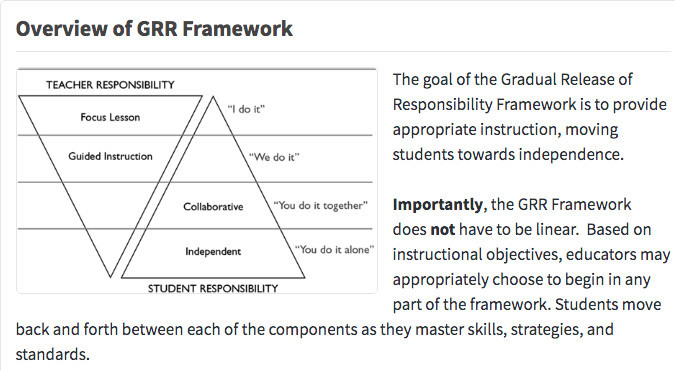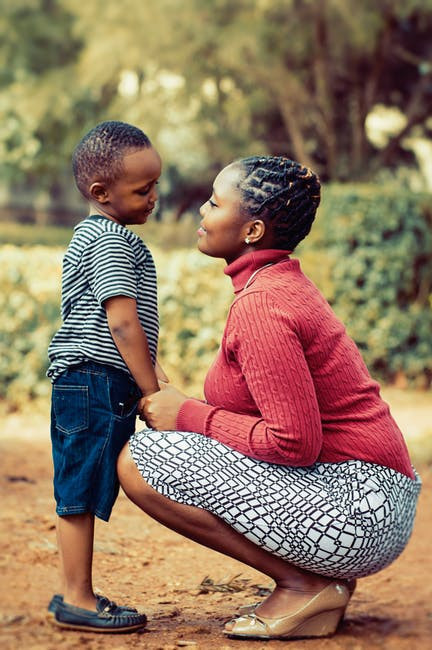Establishing routines for children does not need to be challenging. And, when you do it effectively, it’ll make your parental workload so much lighter.
Imagine how you’d feel if you woke-up and found your child fully dressed with his/her bed made and teeth brushed. This is what happens when you establish routines at home with children. They may resist at first, but soon your child will quickly complete his/her routines and show you the results proudly.
I use the Gradual Release of Responsibility Model to introduce new concepts to my children. I used this model effectively as a classroom teacher. Then, when I became a parent, I struggled to get my kids to complete the routines I’d created for them. So, I turned to this model once again. This is how it works.
The Gradual Release of Responsibility
This is what the gradual release of responsibility model looks like in a classroom:

To apply this model at home, simply substitute the word ‘teacher’ for parent. The easiest way to think of this model is:
“I do it.” (Parent)
“We do it.” (Parent and Child)
“You do it together.” (Two children/siblings/stuffed animal)
“You do it alone.” (Child only)
If your child doesn’t have a sibling to do the “You do it together” step, you can have him try the routine with Daddy, Grandma, or a favorite stuffed animal.
I Do It
For this step, you’ll want to post your routine checklist in your room. Your child will find this funny. Then, you’ll model completing the routine in front of your child. If the second step is ‘Make your bed’, show your child how you make your bed once you’re dressed each morning. You may have to start this practice if you’re not doing it already. Remember, children learn more from what we do than what we say…
Go through the routine in order. Show your child how you follow the routine for a few mornings. You may even find your child trying to copy you.
Once your child has seen you complete the routine a few times, it’s time to hang the routine checklist in his/her room and do the routine together.
We Do It
Now you have the routine checklist posted in your child’s room. Together, you go through each step. Perhaps you’ll help your child get dressed and make his bed. Then, you’ll go to the bathroom to brush teeth, comb hair, and maybe even apply sunscreen.
Depending on the age of your child, you make need to stay at this step for a long time. I introduced a morning routine to my son when he was three. I continued helping him complete this routine for nearly two years. By the time he was five, he was happy to do the entire routine on his own. Although two years may seem like a long time, now that my son is nine, it seems like nothing.
My 9-year-old has been completing his morning routine independently since the age of 5. So, even if your younger child needs you to do the routine with him for a while, that’s okay. One day, he’ll do it independently and you’ll have helped him establish an effective morning routine for life.
You Do It Together
This can be a really motivational step for siblings. When my youngest turned five, he still wanted me to help him with his routine. One day I suggested he work with his older brother to complete the routine and surprise me. My eldest was happy to help (he had the added motivation of a morning cartoon when he and his brother completed all their jobs).
My sons giggled their way through the process. I wondered what I’d find when they finished. At least they were having fun.
Finally, my youngest came to get me. He proudly showed me his made bed and let me inspect his teeth. The bed wasn’t made as neatly as I would do it, but it was good enough.
If you don’t have a sibling to help with this step. Try having a dad or grandparent step in for a change. You’d be surprised how the novelty of someone new changes the dynamics and makes the routine more fun.
You can also have your child’s favorite stuffed animal help him/her with the routine for a few days. Your child can even pretend to help the toy get ready in the morning. Your child can become the teacher to his/her cuddly toy.
You Do It Alone
Your child has finally reached the point where he/she can complete the routine independently. This is the day you’ve been waiting for. The first day he does his routines all by himself, give him a big hug and tell him you’re proud of him.
Soon you’ll be sleeping in on weekends and you’ll wake up to find your child dressed and fed!
More
If you’d like to read this post about the benefits of routines and see my printable templates, check out the following post:
And, if you’d like to see how I transformed our miserable mornings with a routine, read this post:
Win the Morning, Win the Day – Not With Young Children in the House






3 Responses
I’m not a parent yet, but this post is going to be a lifesaver for the time I become a full-time dad. Thanks for sharing your expertise. It’s going to help a lot to teach kids some great benefits of a routine. Much appreciated!
This is really interesting – makes me reflect on how my kids developed certain routines when they were younger. I don’t know if the gradual release of responsibility model addresses if/when it’s ok for kids to “freelance” with an established routine, but I have found with my kids that once they can handle a routine consistently, they’re able to make adjustments (sometimes by choice, sometimes out of necessity) and still get the tasks done, maybe just in a different order.
On the other hand, I’m curious what you think is the best way to handle it when a kid becomes less consistent with part of the routine. My daughter (14) is in high school now and she frequently doesn’t make her bed in the morning because she’s rushing to make the school bus. Waking her up earlier unfortunately doesn’t usually help, as she just uses the extra time to move through the rest of her morning routine at a slightly less frenzied pace. If you have any suggestions, I’d love to hear them – thanks!
High school is a tricky time for getting teens to do chores. I imagine I’ll face some new resistance to our routines when my kids reach high school. You probably want to re-establish your expectations the night before (and not at a time when your teen is late for school). Remind her of your expectations and tie them in with her getting to do things she wants. For example, if you complete all of your morning routine (including making the bed) you are allowed screen time or going out on Friday night (whatever it is she wants to do). If, after one reminder only, she doesn’t complete her routines it could be a loss of internet time or going out privileges (again for one day only and then she gets another chance). This can be very effective. My nine-year-old gets sloppy with making his bed and he doesn’t get his morning play time unless he puts in enough of an effort.